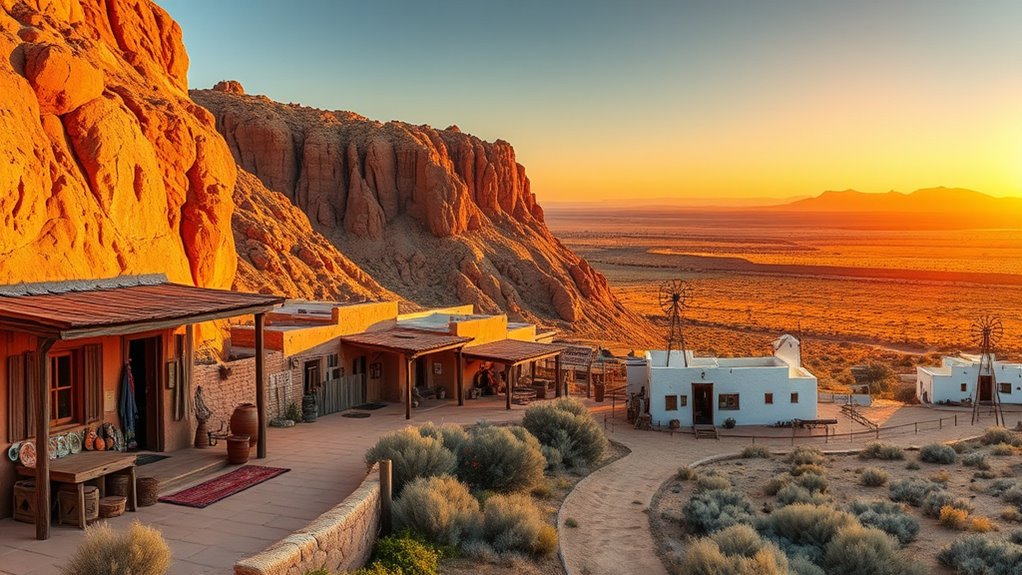In New Mexico, trading posts and farm outposts served as essential hubs for commerce, cultural exchange, and regional growth. These sites connected Native Americans, Spanish colonists, and later settlers, facilitating the exchange of goods like silver, livestock, and agricultural products. They also helped establish social and economic networks that shaped the state’s development. Exploring these outposts reveals how they laid the foundations for New Mexico’s diverse heritage—there’s much more to uncover about their lasting legacy.
Key Takeaways
- Trading posts in New Mexico served as key hubs for distributing goods among Native tribes, Spanish colonists, and settlers.
- Farm outposts supported agriculture, introduced new crops and livestock, and helped connect local producers to broader markets.
- These posts facilitated the exchange of commodities like silver, wool, agricultural products, and crafted goods.
- They became cultural crossroads, blending Native, Spanish, and later Anglo traditions and practices.
- The network of trading and farm outposts laid the foundation for economic growth and regional development in New Mexico.

Have you ever wondered how early traders and settlers established connections across New Mexico’s vast landscape? The answer lies in the intricate network of Native American trade routes and the influence of Spanish colonial agriculture. These paths and practices created a web of commerce that linked distant communities, facilitating the exchange of goods, ideas, and culture long before modern roads crisscrossed the region.
Native American trade routes played a essential role in connecting different tribes and regions within New Mexico. These routes weren’t just simple paths; they were well-established corridors used for trading everything from buffalo hides and turquoise to agricultural products and crafted goods. Tribes like the Apache, Navajo, and Pueblo peoples relied on these routes to sustain their economies and strengthen social ties. They carried goods across rugged terrains, often following natural features such as river valleys or mountain passes, which made travel and trade more manageable. Over time, these routes expanded, forming a complex network that spanned the entire territory, creating a foundation for later European trade and settlement.
Native American trade routes connected tribes, facilitating commerce and cultural ties across New Mexico’s rugged landscape.
When the Spanish arrived and established colonial outposts, they brought with them a new agricultural model rooted in Spanish colonial agriculture. They introduced crops like wheat, grapes, and citrus, along with livestock such as cattle and sheep. These farming practices transformed the landscape and the economy of the region, creating new trade opportunities. Spanish colonists set up missions, ranches, and farm outposts that served as hubs for distributing goods and resources across the territory. These outposts didn’t just supply local needs—they became essential nodes in a broader trade network that connected New Mexico to other parts of New Spain, and eventually, to distant markets.
The combination of Native American trade routes and Spanish colonial agriculture laid the groundwork for the development of trading posts throughout New Mexico. These trading posts served as gathering points where Native traders, Spanish colonists, and later Anglo settlers exchanged goods and information. Some trading posts expanded into essential economic centers, facilitating the movement of commodities like silver, wool, and agricultural produce. They also became cultural crossroads, where different traditions, languages, and practices blended, shaping the unique identity of New Mexico.
In essence, these early trade routes and agricultural practices weren’t just about commerce—they were the arteries that carried life, culture, and resilience across a challenging landscape. They helped establish the connections that made New Mexico a crossroads of diverse peoples and traditions, a legacy that continues to influence the region today.
Frequently Asked Questions
Which Trading Posts Are Still Operational Today?
Many trading posts remain operational today, serving as hubs for modern trading operations and cultural preservation efforts. You can visit places like the Bent’s Old Fort in Colorado or the Santa Fe Plaza, which host ongoing markets and historical demonstrations. These sites actively maintain their heritage while adapting to contemporary commerce. By supporting these locations, you help guarantee their preservation efforts continue and their legacy endures for future generations.
What Goods Were Primarily Exchanged at New Mexico Farm Outposts?
You’re walking a tightrope, but at New Mexico farm outposts, the main trade goods were food items like wheat, corn, and beans, along with livestock and hides. These outposts relied on established supply routes to bring in essentials and exchange local products. Kids, imagine a bustling marketplace where farmers barter their crops and animals, keeping the community alive and thriving through these crucial trade connections.
How Did Trading Posts Influence Local Native American Communities?
Trading posts greatly influenced your local Native American communities by facilitating Native American trade and fostering cultural exchange. You might have noticed that these posts introduced new goods, ideas, and customs, which often blended with existing traditions. While they created economic opportunities, they also sometimes led to cultural shifts and challenges. Overall, trading posts became a crucial point of interaction, shaping your community’s social fabric and mutual understanding through ongoing exchange.
Are There Guided Tours Available at Historic Trading Post Sites?
Of course, you can join guided tour options at historic trading post sites—because who wouldn’t want a charming walk through history? These tours often kick off at the visitor center amenities, where you get a crash course in trading post lore. So, if you’re craving stories, insights, and maybe a few good photo ops, sign up and let the guides do the storytelling while you soak it all in.
What Role Did Trading Posts Play in Regional Defense Strategies?
Trading posts played a key role in regional defense strategies by strengthening military alliances and ensuring frontier security. You can see how these posts acted as strategic outposts, facilitating communication and cooperation between different groups. They helped monitor threats, support military efforts, and maintain stability along frontier regions. Overall, trading posts served as essential hubs for defense, fostering alliances and protecting against invasions or raids, therefore securing the area’s safety.
Conclusion
As you explore New Mexico’s trading posts and farm outposts, remember they’re like modern-day Oases in a desert—hidden gems offering connection and sustenance. Just as the pioneers relied on these outposts for survival, you can find inspiration in their resilience and spirit. Embrace these historic sites as your own gateway to adventure, where every visit echoes the timeless story of exploration and community. So go ahead, forge your path and let history guide you.









